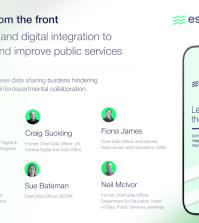Colin MacDonald, CIO for the government of New Zealand: Exclusive Interview

New Zealand’s government chief information officer, Colin MacDonald, explains to Winnie Agbonlahor the digital innovations that prompted the OECD to make him chair of its e-leaders summit
The OECD’s e-leaders’ meeting brings together some of the world’s most senior digital government officials – and its new chair is New Zealand’s government chief information officer, Colin MacDonald. This is a big deal. At the last e-leaders’ meeting in September, more than 30 nations took part; it is one of a handful of forums bringing together the world’s leading digital government chiefs. And MacDonald, who will chair the meeting for three years, says the post represents international recognition of the New Zealand government’s ambitious and effective digital reform programme.
“I think what the OECD really liked is that we are driving our ICT changes from a citizen’s perspective,” says MacDonald. Under the government’s ICT strategy, MacDonald’s team is working on “integrated services” based on life events, which means internet users wouldn’t need to know about, or even deal directly with, the numerous agencies delivering the individual services, but would be able to access all the services they need at one time.
The government expects to start prototyping integrated services around the birth of a child by the end of 2016. “The vision is that citizens will be able to access the services they need when they need them,” he explains. While Govt.nz is expected to be an “important channel” in this endeavour, it won’t be the only one,” MacDonald adds. “Part of the work on integrating services currently delivered by several agencies will also be to understand what other channels will best reach our customers and develop a new model for delivery.”
Take the birth of a child. Being a new parent is a “fantastic time of life,” MacDonald says. “But you find that you have to transact with about six or seven different government departments: the Department of Internal Affairs to register the birth; the tax office to get a tax number; the health service to get a National Health number; and so on. At the moment, you’ve got to navigate your way through all of that, whereas we want to make it so that you can go to one place and get all of that done.”
The other four life events are getting a job; renting a home; becoming a victim to or witness of a crime; and reaching retirement age. The first event to go live will be the birth of a child as integrated services around this are currently the most advanced, MacDonald explains.
The force behind the move towards integrated services is the Service Innovation Group, which has been “driving the way we want to change the citizen experience” of public services, MacDonald explains. It is one of four working groups reporting to a team of 12 chief executives drawn from across government, forming a board “who are stewarding the ICT changes that we’re making across government.”
While the Service Innovation Group is tasked with coming up with innovative ways of reforming services, the Technology Group – made up of departmental chief information officers – “is looking at the right platforms to be using”; the Information Group is “looking at how we make sure that our information is treated as an asset, and that we’ve got really secure and safe ways of flowing information between agencies in response to service improvements”; and the Strategic Investment Group, made up of departmental chief finance officers, is considering “innovative funding models.”
MacDonald’s team is currently working on these projects and trying to answer a series of questions: “We have yet to figure out the challenges around producing these types of services,” he acknowledges. “If you’re producing a service that is really an aggregation of services from five or six different agencies, who has accountability for delivering it? What’s the right service model? How do you support it? There’s a whole bunch of questions that it raises, and we’re using these [five] pilot projects as a way to work our way through some of these quite significant issues.”
Another big area of focus for MacDonald’s team is digital identity. The big offering in this area is RealMe,which “allows a user to identify themselves in a very reliable way in a digital environment, but it also gives them the ability to consent to having their information shared between different government services.” McDonald describes these services as a “cornerstone” of New Zealand’s approach to digital government. Rolling it out isn’t easy, because “there are lots of agencies that already have their own authentication methods.” But there has been steady progress, and so far more than 2m people have logged onto government services using RealMe – which is now being used by 30 government agencies.
In his CIO’s role MacDonald has a core team of 25 people, but he can also draw on the resources of the Department for Internal Affairs – of which he is chief executive. The post of CIO hasn’t always had such support. In the years before MacDonald was appointed, the role of government CIO was part of the State Services Commission – New Zealand’s central policy agency – and thus rather isolated from delivery ministries.
But in 2011, state services commissioner Iain Rennie moved the GCIO role into a department; and he chose the Department of Internal Affairs, in order to boost the CIO’s influence with departmental leaders. “We felt that having a peer work with other chief executives would help to get traction in the system-wide changes that we wanted to make,” MacDonald says. MacDonald was appointed GCIO in 2012 and soon after that, the government launched its ‘Ten Better Public Services Results’ – a set of over-arching government goals aimed at achieving more cross-departmental collaboration.”
In MacDonald’s experience, the centre of government can’t drive truly sustainable, system-wide change: while a central reform team can achieve great leaps by “disrupting the status quo and getting things moving,” he argues that “ultimately the disruptive influence does run out of steam, and you need to go from a disruptive phase to an embedding phase.” This second phase, he believes, can only be achieved through “a lot of collaborative working.”
MacDonald notes that some countries have “had difficulties” after attempting to pursue centrally-driven change, “because agencies have not necessarily been taken on the journey and it doesn’t get embedded into the broader public management model”.
That’s not to say, he hastens to add, that New Zealand’s model has yet been proven effective: “I don’t know if we’re being successful, it’s too early to tell,” he says. “But we’re trying to make sure that by a combination of some central leadership and a lot of collaborative working, that we are helping to embed the way things need to change within line agencies – because in the end it’s line agencies that have to deliver.”
Working with other countries on digital services, MacDonald says he’s realised that “we’re all grappling with the same challenge” – modernising public service delivery to keep up with citizens’ fast-rising expectations. Governments around the world find themselves being judged against the standards being set by the private sector, he says: “We’re experiencing such levels of choice now when we access private sector services that if the public sector doesn’t keep up with that, I think citizens will begin to lose a bit of faith in government’s ability to deliver.”
MacDonald adds that “everybody’s getting there in a slightly different way, based on their individual country and their individual context, but we’re all kind of heading that way, which is quite reassuring.” He wants to find out more about other countries’ experiences and share best practice – and he’s well placed to do so. If there’s one person with the contacts and channels to identify and share best practice in digital government, wherever it lies in the world, it’s the new chair of the OECD’s e-leaders meeting.
CV Highlights
1980: Graduates from the University of Glasgow with a BSc degree in computer science
1980: Becomes analyst and programmer for A Goldberg and Sons Ltd department store (UK)
1982: Joins Total Oil Marine plc (UK) as analyst
1994: Becomes a chartered engineer
1995: Moves to New Zealand to work for ANZ Banking Group Limited as chief manager, operations, and is later promoted to chief operating officer
2001: Joins New Zealand’s public service as deputy commissioner, business development and systems, for the Inland Revenue Department
2008: Appointed chief executive of Land Information New Zealand – the government department responsible for New Zealand’s system of land transfer, the regulation of the property sector, leadership of the New Zealand Geospatial Strategy, and the management of Crown land
2012: Becomes chief executive of the Department of Internal Affairs and government chief information officer
The Global Government Forum: Five Thoughts for Better Government
Can you name one lesson or idea from abroad that’s helped you or your colleagues?
“The UK government gave us all of the open source code for the gov.uk website and we’ve based our gov.nz website on that and it’s established a really good relationship between our team here and the UK team in the ongoing development of those platforms. That was fantastic and we really appreciate it.”
Are there any projects or innovations in your country that might be valuable to your peers overseas?
“I think that the work we’re doing on digital identity is a huge topic with the OECD members and everybody’s really interested in it. We’ve got Estonia on one side, who have a [strong] digital identity profile, but everybody else is really grappling with this, so I think our work on digital identity could be really helpful.”
How can we improve the ways in which senior public officials work with and learn from their peers overseas?
“I think, having worked for a lot of my career in the private sector, I have to say one of the great strengths of the public sector, is that we do share ideas with overseas colleagues. But I think we could do it better, and be better at actually using technology to be able to share ideas in more of a real-time. I think we still work in a bit of an old model where we get together in a physical location and exchange ideas. It would be great to be able to do more of that virtually.”
What are the global challenges within your field over the next five years?
“I think it’s twin challenges: growing citizen and business expectations about the nature of government services; and the increasing cyber-security issues that all countries are facing. So the more we put online, the more we make our services open, potentially the more at risk they are and we have to pay a lot of attention to the cyber risks while we’re doing that.”
What is your favourite book and why?
“I don’t have a favourite book but I’m currently reading Shogun by James Clavell. It is a fascinating insight into Japan’s history and perhaps gives some kind of insights into them as a nation – but only some. Although it’s a novel, it’s also a fascinating historical insight into that country.”
Related partner content: CloudCheckr enables government to move more operations into the cloud by meeting your security and cost requirements. Approved government supplier: click for more details and a free trial
For up to date government news and international best practice follow us on Twitter @globegov
See also:
Interview: Gabriel Makhlouf, Treasury, New Zealand
New Zealand’s top official Iain Rennie to step down in June
Interview: Iain Rennie, state services commissioner, New Zealand
New Zealand develops new tool for social service providers showing where children are at risk
Interview: Paul Shetler, chief executive, Digital Transformation Office, government of Australia
Interview: Mike Bracken, former head of the Government Digital Service (GDS)
Interview: Jane Halton, Secretary, Department of Finance, Australia





















